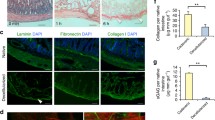Abstract
Engineering three-dimensional tissues in vitro for regenerative therapy is highly desired. Vascular beds with connectable arteries and veins play crucial roles in fabricating three-dimensional tissues in vitro and improving the survival rate of transplanted three-dimensional tissues in vivo. Here, we developed a method to reconstruct a new vascular bed that could be implanted into humans for clinical applications. Porcine small intestine with an arteriovenous loop was selected as a vascular bed skeleton and decellularized using transvascular perfusion with both detergent and enzyme. Subsequently, the decellularized intestinal graft was re-endothelialized with human cells to allow blood perfusion into the vascular bed. The small intestinal graft was successfully decellularized without severe damage to the burst pressure of the graft, and the decellularized intestinal graft could be transplanted without a severe inflammatory response in rats for two weeks. In addition, the decellularized intestinal graft was partially vascularized with human endothelial cells in seven days. Therefore, the reconstructed intestinal vascular bed may serve as a human transplantable vascular bed with potential in clinical investigations.
Access this chapter
Tax calculation will be finalised at checkout
Purchases are for personal use only
Similar content being viewed by others
References
Okano, T.: A novel recovery system for cultured cells using plasma-treated polystyrene dishes grafted with poly(N- isopropylacrylamide). J. Biomed. Mater. Res. 27(10), 1243–1251 (1993)
Shimizu, T.: Cell sheet engineering for myocardial tissue reconstruction. Biomaterials 24(13), 2309–2316 (2003)
Shimizu, T.: Cell sheet-based tissue engineering for fabricating 3-dimensional heart tissues. Circ. J. 78(11), 2594–2603 (2014)
Memon, I.A.: Repair of impaired myocardium by means of implantation of engineered autologous myoblast sheets. J. Thorac. Cardiovasc. Surg. 130(5), 1333–1341 (2005)
Sawa, Y.: Tissue engineered myoblast sheets improved cardiac function sufficiently to discontinue LVAS in a patient with DCM- report of a case. Surg. Today 42(2), 181–184 (2012)
Sawa, Y.: Safety and efficacy of autologous skeletal myoblast sheets (TCD-51073) for the treatment of severe chronic heart failure due to ischemic heart disease. Circ. J. 79(5), 991–999 (2015)
Shimizu, T.: Fabrication of pulsatile cardiac tissue grafts using a novel 3- dimensional cell sheet manipulation technique and temperature-responsive cell culture surfaces. Circ. Res. 90(3), e40–e48 (2002)
Sekine, H.: In vitro fabrication of functional three-dimensional tissues with perfusable blood vessels. Nat. Commun. 4, 1399 (2013)
Inui, A.: Generation of a large-scale vascular bed for the in vitro creation of three-dimensional cardiac tissue. Regen. Ther. 11, 316–323 (2019)
Crapo, P.M.: An overview of tissue and whole organ decellularization process. Biomaterials 32(12), 3233–3243 (2011)
Totonelli, G.: A rat decellularized small bowel scaffold that preserves villus-crypt architecture for intestinal regeneration. Biomaterials 33(12), 3401–3410 (2012)
Simsa, R.: Effect of fluid dynamics on decellularization efficacy and mechanical properties of blood vessels. PLoS ONE 14(8), e0220743 (2019)
Mirmalek-Sani, S.H.: Immunogenicity of decellularized porcine liver for bioengineered hepatic tissue. Am. J. Pathol. 183(2), 558–565 (2013)
Cebotari, S.: Detergent decellularization of heart valves for tissue engineering: toxicological effects of residual detergents on human endothelial cells. Artif. Organs 34(3), 206–210 (2010)
Ott, H.C.: Perfusion-decellularized matrix: using nature’s platform to engineer a bioartificial heart. Nat. Med. 14(2), 213–221 (2008)
Uygun, B.E.: Organ reengineering through development of a transplantable recellularized liver graft using decellularized liver matrix. Nat. Med. 16(7), 814–820 (2010)
Doi, R.: Transplantation of bioengineered rat lungs recellularized with endothelial and adipose-derived stromal cells. Sci. Rep. 7(1), 8447 (2017)
Acknowledgments
This research was supported by the “Development of innovative manufacturing technology for three-dimensional tissues and organs based on cell sheet engineering” from the Japan Agency for Medical Research and Development (AMED, https://www.amed.go.jp/en/index.html; grant no. JP17he0702249) and JSPS KAKENHI Grant Number JP 18J22398. We would like to thank Editage (www.editage.com) for English language editing.
Author information
Authors and Affiliations
Corresponding author
Editor information
Editors and Affiliations
Ethics declarations
Kazunori Sano is an employee of Tokai Hit Co., Ltd (Japan). Tatsuya Shimizu is a member of the scientific advisory board and a shareholder of CellSeed Inc. (Japan). Tokyo Women’s Medical University received research funds from CellSeedInc. Tokyo Women’s Medical University received a research grant from Tokaihit Co., Ltd, Japan.
Rights and permissions
Copyright information
© 2021 Springer Nature Switzerland AG
About this paper
Cite this paper
Tobe, Y. et al. (2021). Reconstruction of a Vascular Bed with Perfusable Blood Vessels Using a Decellularized Porcine Small Intestine for Clinical Application. In: Shiraishi, Y., Sakuma, I., Naruse, K., Ueno, A. (eds) 11th Asian-Pacific Conference on Medical and Biological Engineering. APCMBE 2020. IFMBE Proceedings, vol 82. Springer, Cham. https://doi.org/10.1007/978-3-030-66169-4_35
Download citation
DOI: https://doi.org/10.1007/978-3-030-66169-4_35
Published:
Publisher Name: Springer, Cham
Print ISBN: 978-3-030-66168-7
Online ISBN: 978-3-030-66169-4
eBook Packages: EngineeringEngineering (R0)




